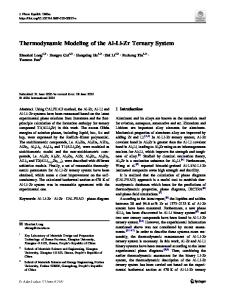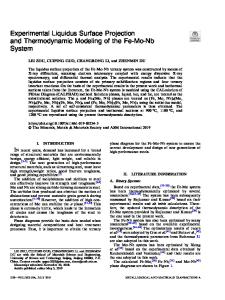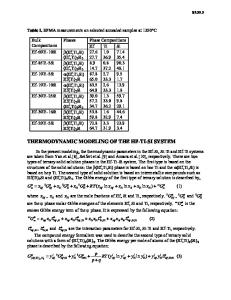Thermodynamic Modeling of the Cr-Fe-S System
- PDF / 1,083,831 Bytes
- 17 Pages / 593.972 x 792 pts Page_size
- 51 Downloads / 421 Views
INTRODUCTION
AS chromium sulfides represent the basic products of high-temperature reactions between chromium-alloyed materials and sulfuric environments, the chromiumiron-sulfur system plays a fundamental role in the field of material science with respect to hot corrosion. A profound knowledge of the thermodynamic stability of chromium-iron sulfides supports investigations to find which phase assemblages can principally occur as corrosion products. The system Cr-Fe-S is characterized by the occurrence of two ternary solid solutions, high-temperature chromium-iron pyrrhotite, and the thiospinel phase Daubre´elite.[1–4] Daubre´elite exists within a relatively small homogeneity range while being in equilibrium with various binary and ternary phases. High-temperature chromium-iron pyrrhotite emanates from binary iron and chromium pyrrhotite forming a continuous solid solution series over the wide ranges of composition and temperature. The mutual solubility of other binary iron and chromium sulfides is limited. The solubility of sulfur in the solid alloy phases is small. According to the miscibility gaps in the metal-sulfur binary systems, the liquid phase as third extended complex solution shows demixing in chromium-rich regions as well as in the sulfur corner. Jacob et al.[5] used experimental and estimated thermodynamic data to calculate phase stabilities in the system Fe-Ni-Cr-S relevant for studying the sulfidation behavior of stainless steels. Oikawa et al.[6] performed Gibbs energy modeling of Fe-Cr-S phases and calculated phase equilibria on the basis of a thermodynamic PETER WALDNER, Assistant Professor, is with the Department of General, Analytical and Physical Chemistry, University of Leoben, Franz-Josef-Straße 18, 8700, Leoben, Austria. Contact e-mail: [email protected] Manuscript submitted December 20, 2012. Article published online October 1, 2013 798—VOLUME 45A, FEBRUARY 2014
evaluation of the Fe-FeS-CrS-Cr system. Two-sublattice models were used for the ternary liquid phase as well as for the alloy phases with body- and face-centered structure. Chromium-iron pyrrhotite was described as stoichiometric monosulfide according to (Cr,Fe)S. For the Sigma phase, the assessment of Andersson and Sundman[7] was accepted assuming no sulfur solubility. The motivation of the present study is a comprehensive thermodynamic description of the ternary Cr-Fe-S system over the complete composition range from ambient to liquidus temperatures. In order to provide consistency with previous modeling work on the subsystems Cr-Fe,[7–9] Fe-S,[10] and Cr-S[11] and compatibility within a metal-sulfur database including the systems Ni-S[12,13] and Fe-Ni-S,[14–18] the models for ternary solutions have to be based on binary interactions calculated in the studies.[7–11]
II.
EXPERIMENTAL DATA
The experimental information used for this modeling study can be classified into two groups: phase equilibria, and thermodynamic data. The first group covers information about phase boundaries, e.g., in isothermal sections. The second group
Data Loading...











